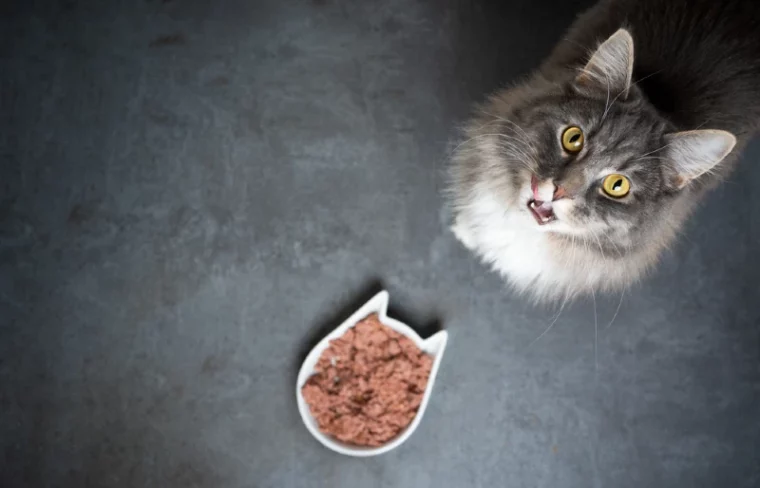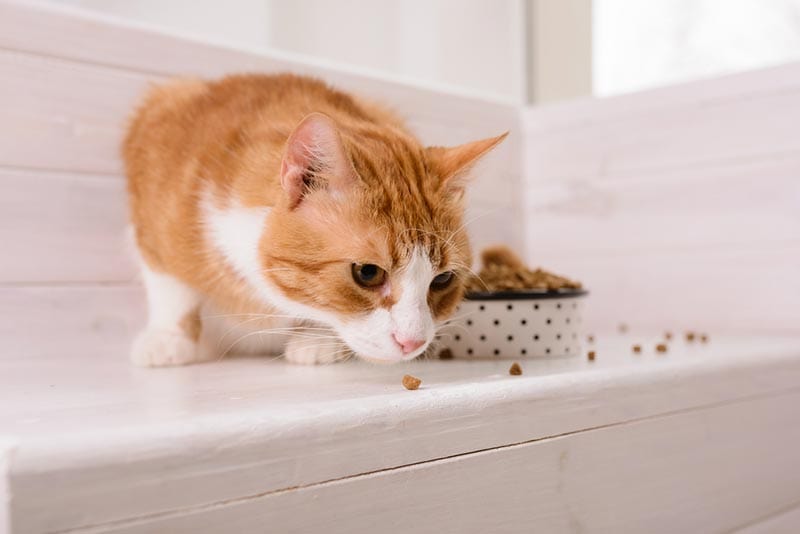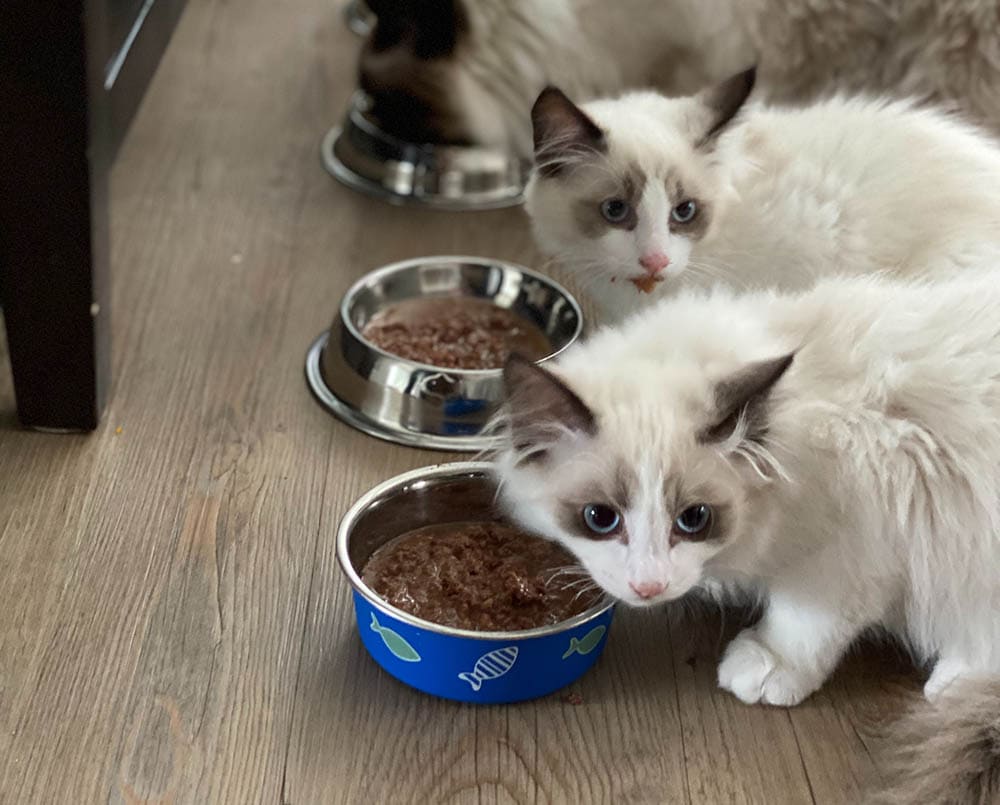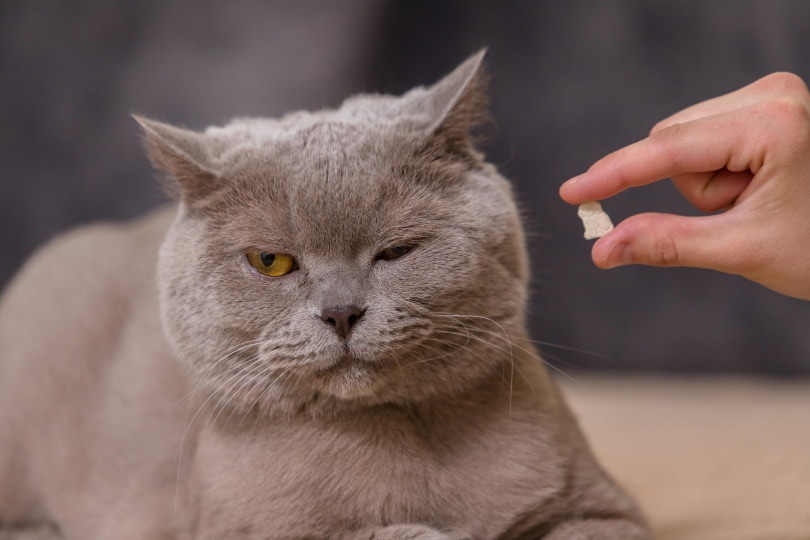
Click to Skip Ahead
Cats like what they like and hate what they don’t. While it would be nice if your feline could eat the same formula for their entire life, occasionally it becomes necessary to switch their recipe due to changes in age, health, taste, or even the food itself. Here are some ways to entice your picky kitty to try their new food and ease their stomach for a smooth transition.
Top 3 Tips to Switch Your Cat’s Food
1. Transition Over a Week
Whenever it’s time to switch, try to plan ahead and change the food gradually. This will reduce the risk of stomach upset. Start by feeding your cat 25% of the new food mixed with 75% of the old. If your cat has no issues after a couple days, gradually go up to 50% and then 75% and so forth. Finally, after a week of increasing the amount of new food, you’re probably safe to only feed them the new formula.

2. Tempt Them with Something They Like
Maybe you know your cat purrs for rotisserie chicken or licks their lips when they see tuna juice drizzling out of the can. You might try to mix in a tiny amount of their choice treat to encourage them to eat the new food. They may decide they like the new recipe, too, but they’ll never know if they’re reluctant or picky eaters who are too set in their ways to touch the unfamiliar formula.
3. Try a Different Flavor or Texture
Cat foods often come in different flavors. Usually, the biggest variable is the featured meat. You might find that your cat loves fish but turns away if turkey hits the plate. Another difficulty can be a change in texture. There are so many to choose from these days; dry, semi-moist, stew, meatloaf style and so on. You may need to try a different texture of food that your cat will go for. Find what they like and try to cater to their tastes as much as possible.

When Your Cat May Need a Different Recipe
Your cat’s body changes as they age due to a bunch of factors. The transition from kitten days to adulthood will probably require switching foods unless you’ve been feeding them a formula that’s created for all life stages. Similarly, elderly cats have different nutritional needs than adults in their prime, so you might consider switching to a senior formula later in life.
Generally, you will want a food regardless of the life stage that is high in protein and low in plant-based materials. Cats are obligate carnivores, which means they need to eat meat to live. Ideally, 80% of the ingredients in your cat’s food should be meat. They must be receiving a diet that is complete and balanced for all the essential nutrients that they need. Look for the AAFCO statement on the food label or the phrase complete and balanced. Always talk to your vet about the best type of food for your cat if they have specific health concerns such as diabetes or kidney trouble.
Make sure you’re feeding your cat the right type and amount of food for their lifestyle, check out our cat food calculator here:
The exact amount of calories an individual animal needs to maintain a healthy weight is variable and influenced by many factors including genetics, age, breed, and activity level. This tool is meant to be used only as a guideline for healthy individuals and does not substitute veterinary advice
 Frequently Asked Questions
Frequently Asked Questions
My cat hates its new food. What should I do?
You can try to mix in something you know your cat loves to see if they’ll give their new food a chance. Cats are notoriously picky eaters, however, so you might want to try to find an alternative if a few days pass and they still aren’t receiving it well. If you’re switching foods because of a medical condition, ask your vet if there’s a comparable choice that your cat might find more palatable.

Why did my cat only eat the new food for 3 days?
It is a well-known phenomenon that cats may appear to be enjoying their new food, neophilia, eating it with gusto. Then all of a sudden 3 days later they won’t touch it. This is a frustrating problem that can be best avoided by slowly transitioning food from one to the other.
I’ve been gradually switching the food, but my cat has still developed GI issues. Should I switch back to the old formula?
It depends on why you switched to begin with. Gradually adding a higher ratio of new to old food over a week can help your cat’s stomach adjust, but occasionally you’ll find a food that just doesn’t sit well with your cat. A little loose stool can be normal for the first few days, but if more than a couple days pass and it hasn’t resolved, then it might be time to go back to their old food if it was working or try to find another option if you switched for medical reasons. Always call your vet if your cat has diarrhea multiple times over 24 hours, or if you see any blood in their stool.
Conclusion
Successfully switching your cat to a new food can be challenging, but worth it, once the transition is complete. It’s normal for your cat’s stomach to be a little upset during the first few days. However, gradually switching foods should keep their tummy from feeling too bad, and all of these issues should be resolved within a couple of days. If they don’t go away, or if you see any blood in your cat’s fecal matter, call your vet and discuss alternative recipes that fit your cat’s needs.
Featured Image Credit: Nils Jacobi, Shutterstock







